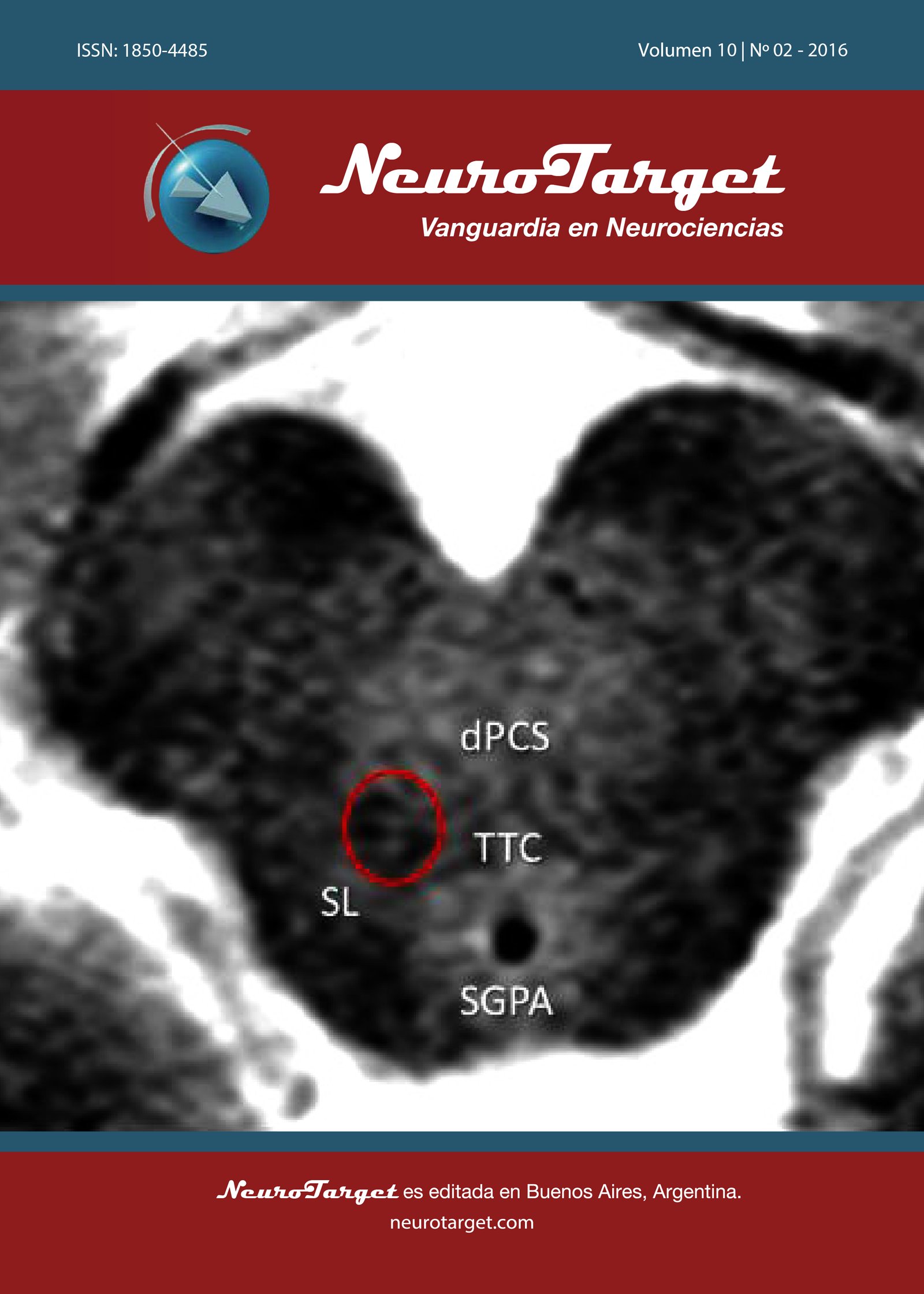Unilateral Stimulation of Prelemniscal Radiations for the Treatment of Acral Symptoms of Parkinson´s Disease: Long-Term Results.
Published in the journal Neuromodulation 2016; 19: 357–364. Translation: Dr. Carolina Ramírez Gómez.
DOI:
https://doi.org/10.47924/neurotarget2016189Keywords:
Bradykinesia, Electrical stimulation, Parkinson´s disease, Prelemniscal radiations, Rigidity, TremorAbstract
Background: Prelemniscal radiations (Raprl) have been proposed as a target for the treatment of Parkinson´s disease. We evaluated effectiveness of this target through UPDRS-III in patients treated with Raprl deep brain stimulation (Raprl-DBS) and followed from 24 to 48 months.
Methods: Nineteen patients in Hoehn-Yahr stages II–III were implanted with tetrapolar deep brain stimulation electrodes in Raprl contralateral to the extremities with more prominent symptoms. Placement was assisted by MRI/CT/anatomical atlas fusion, microelectrode recording, and micro- and macro-stimulation. The effect on motor symptoms was evaluated in an open label protocol through specific items of the UPDRS-III score, applied pre operatively and 6, 12, 24, and 48 months after the onset of stimulation in an OFF-medication/ ON-stimulation condition. Changes in scores with regard to preoperative condition were obtained for each symptom in both sides and statistical significance determined through double-tail Wilcoxon test. Influence of demographic variables on outcome was analyzed using linear regression testing.
Results: A greater than 80% decrease in UPDRS score for contralateral symptoms (classified as excellent results) occurred in 14 patients (73.7%), while in the other 5 it decreased from 33 to 79% (considered suboptimal results). These changes remained statistically significant up to 48 months (p<0.01), while ipsilateral symptoms progressively increased. Suboptimal results were associated with selective improvement of only one symptom.
Conclusion: Raprl-DBS induces a long-term, significant improvement of contralateral acral symptoms of Parkinson´s disease.
Metrics
References
Odekerken VJ, van Laar T, Staal MJ, Mosch A, Hoffmann CF, Nijssen PC, Beute GN, van Vugt JP, Lenders MW, Contarino MF, Mink MS, Bour LJ, van den Munckhof P, Schmand BA, de Haan RJ, Schuurman PR, de Bie RM. Subthalamic nucleus versus globus pallidus bilateral deep brain stimulation for advanced Parkinson’s disease (NSTAPS study): a randomised controlled trial. Lancet Neurol 2013;12:37-44.
Deuschl G, Paschen S, Witt K. Clinical outcome of deep brain stimulation for Parkinson’s disease. Handb Clin Neurol 2013; 116:107-28.
Kinfe TM, Vesper J. The impact of multichannel microelectrode recording (MER) in deep brain stimulation of the basal ganglia. Acta Neurochir Suppl 2013;117: 27-33. Review. PMID:23652653
Halloway K, Docef A. A quantitative assessment of the accuracy and reliability of O-arm images for deep brain stimulation surgery. Neurosurgery 2013;72 (ONS Suppl 1): ons47–on.
Shahlaie K, Larson PS, Starr PA . Intraoperative computed tomography for deep brain stimulation surgery:technique and accuracy assessment. Neurosurgery 2011;68 (ONS Suppl 1): ons114-ons24.
Celman C, Ramakrishnan V, Davies A, Holloway K. Analysis of stereotactic accuracy of the Cosman- Robert-Wells frame and Nexframe frameless systems in deep brain stimulation surgery. Stereotact Functc Neurosurg 2010;88(5):288-95.
Starr PA , Christine CW, Theodosopoulos PV, et al. Implantation of deep brain stimulators into the subthalamic nucleus: technical approach and magnetic resonance imaging-verified lead locations. J Neurosurg 2002;97(2):370-87.
Downloads
Published
How to Cite
Issue
Section
License
Copyright (c) 2016 Francisco Velasco, José D. Carrillo-Ruiz, Víctor Salcido, Guillermo Castro, Julián Soto, Ana Luisa Velasco

This work is licensed under a Creative Commons Attribution 4.0 International License.
The article is distributed under the Creative Commons Attribution 4.0 License. Unless otherwise stated, associated published material is distributed under the same licence.







